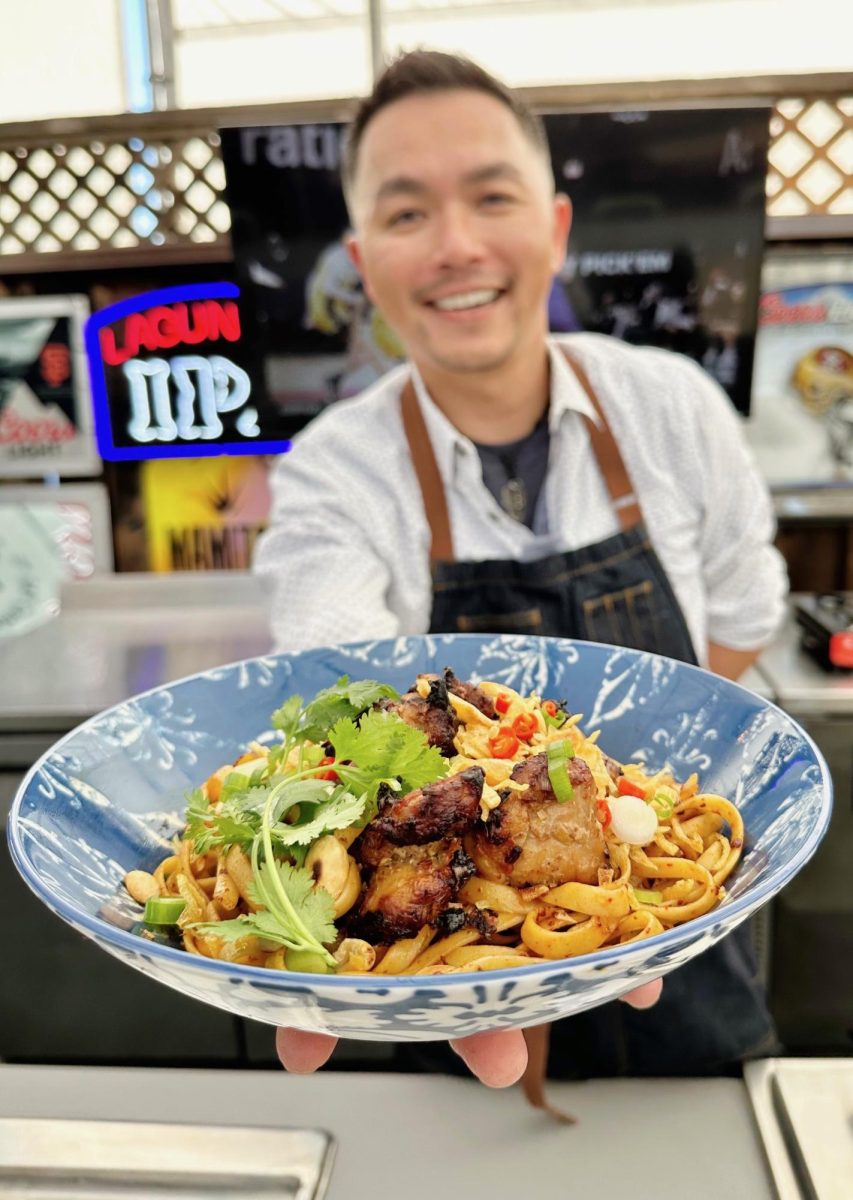
Jeremiah Fung
Chimichurri Chicken Noodles - Creating a fusion of Latin American and Asian flavors, Chef Jimmy Vo presents this delicious and savory combination
Lemongrass pork tacos, sushi burritos, and butter chicken pizzas. These seemingly strange and original food combinations fall under the category known as fusion food. Ingredients and techniques from cuisines around the world “fuse” together, resulting in a beautiful creation or an abomination to the food world.
Fusion foods have existed for centuries. Just as trade, colonization, and immigration have led to different countries influencing each other’s traditions in music, language, and art, the same is true for food. According to modern French Chef Alexis Aubert, by trying fusion food, a country’s history is put on full display.
“What gives me the most pleasure is to discover the culture of that country through their cuisine,” Aubert told Chomp. “It’s through food that I’m able to understand their history, technique, and what their native ingredients are.”
One example of this is Tex-Mex, a popular style of food that combines Texan and Mexican cuisine, such as deep-fried burritos known as chimichangas. Chimichangas feature the American technique of deep frying and the traditional northern Mexican burrito. These two influences show the history of Mexican immigration, and the many people of Mexican descent who came to Texas and incorporated their own techniques and ingredients into the local cuisine.
Although its existence has been long-lasting, the idea of ‘fusion food’ was only first popularized in the 1970s when a few French chefs decided to add typically Asian ingredients to French dishes.
Now, with the worldwide accessibility of the internet, fusion food ideas no longer rely on physical culture merges. As a result, fusion food has gained a lot of popularity and inspired many people to create fusion dishes.
However, the creation of fusion food is not simple, and mashing together two dishes from vastly different cultures doesn’t always work. Chef Jimmy Vo who calls himself ‘Umami Man’ who runs pop-up stands in the Bay Area believes the key to success in fusion food is to understand the ingredients and the flavors that accompany them.
“People think that one cuisine is just one cuisine,” Vo said. “But if you really take time to understand each herb, each flavor, each seasoning, each ingredient, and look past what they’re tied to and what they’re rooted to, then I think you can make it all work.”
Aubert also agrees with this sentiment, advising that cooks keep the flavors well-balanced, as overlapping too many distinct flavors can result in an overwhelming taste.
“I love taking French recipes and adding a touch from Lebanon, or Japan, for example, adding soy sauce to modernize it, but it has to be well-balanced because it can quickly become a disaster,” Aubert said.
In Palo Alto, fusion restaurants like Sushirrito and Curry Pizza House have prospered. Sushirrito sells sushi rolls the size of a burrito, wrapped in nori instead of a tortilla. Curry Pizza House makes pizzas but replaces the traditional sauces and toppings with curry sauce, and tikka chicken.
These combinations have the ability to create something exceptional and expose customers to new ingredients and techniques, giving an insight into different cultures.
“Even though the Indian pizzas can seem to have obscure toppings, the flavors come together so well and they have a huge variety of combinations, which all have a different twist,” Palo Alto High School junior Anjini Sanchorawala said.
Still, some say that fusion cuisine can be regarded as disrespectful. Many countries have a signature dish that carries a high traditional value. Fusion food can sometimes disrespect this history by carrying the same name as that dish, but not following the same ingredients or techniques.
“When people call California rolls or dragon rolls sushi, it kind of makes me mad and I think it’s disrespectful to Japanese culture,” Paly sophomore Koji Silverberg-Shirota said. “I don’t think California rolls or dragon rolls with weird spices should be called sushi because it’s not traditional.”
Another example of fusion food that can be considered disrespectful is Panda Express and Taco Bell being described as Chinese or Mexican food. For some, these restaurants are cheap and heavily American-influenced knockoffs that disrespect the original dish.
“I think it’s just people from the United States recreating Mexican food, and Taco Bell is very stereotypical,” Paly junior Santiago Sanchez said. “I don’t think it’s Mexican food.”
On the other hand, Vo says food doesn’t belong to any specific culture, and as long as it’s done well there shouldn’t be any problems.
“People just automatically think that certain foods belong to certain cultures, but I think that food is a diverse thing,” Vo said. “You’ve got to stop putting a label on it. I guess food is food to me, and if it tastes good, and it works together, it’s fine.”
Fusion food and cultural diversity in local cuisine can expose people to so many different flavors and Vo thinks that we should be grateful that we have that in the Bay Area.
“When it comes to diversity in terms of cultural food in the Bay Area, they [East Coast] doesn’t have anything on the Bay Area,” Vo said. “I think it’s just we’re fortunate being in the Bay Area to experience all this stuff.”
wrap